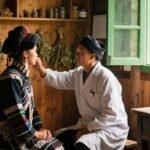My nephew Yingchang, who frequently traveled for business and had irregular eating habits, suddenly developed eruptive macules (known as ban zheng in Chinese medicine) in April. When the rashes were still indistinct, we consulted a physician named Dong. Mistaking it for seasonal influenza with indigestion, Dong prescribed Wuji San (Five Accumulations Powder) — a formula containing Cangzhu (Atractylodes rhizome), Jiegeng (Platycodon root), Chenpi (Tangerine peel), and other warming herbs — which worsened his condition. His entire body turned scarlet like cinnabar, and the whites of his eyes became completely red.

An elderly female therapist skilled in massage was later summoned. Recognizing the eruptive nature of the disease, she performed bloodletting by pricking his tongue and perineum with needles. Though this stabilized his breathing and slightly cleared his mental state, the fever persisted.
Upon my examination, I observed profuse facial sweating and cracked lips — signs of Stomach Channel heat (the Yangming system in Chinese medicine). His pulse felt deep (chen) and rapid (shu). Urine appeared dark, stools were normal, and the abdomen felt soft upon palpation. This indicated yin deficiency heat (insufficient bodily fluids causing internal heat) rather than excess heat requiring purgation. Cooling and nourishing therapy was appropriate.
I prescribed Zhibai Dihuang Tang (Anemarrhena-Phellodendron-Rehmannia Decoction), comprising Zhimu (Anemarrhena rhizome), Huangbai (Phellodendron bark), Shudihuang (steamed Rehmannia root), and other yin-nourishing herbs. The fever diminished after the first dose and resolved completely following the third. Though bedridden with sallow complexion and emaciation, he craved food urgently. I advised: “The pathogen has cleared. No further medication is needed, but meals must be light and modest to (helps maintain) relapse.” Full recovery followed a month of dietary moderation. This case exemplifies yin re zheng (Yin Heat Syndrome).
- Herbal names use:
- Standard pharmacological English (e.g., Anemarrhena rhizome) + pinyin (Zhimu) without tones
- Formula names in pinyin with literal translations (e.g., Wuji San / Five Accumulations Powder)
- Anatomical terms clarified (e.g., “perineum” instead of huiyin)
- TCM concepts explained parenthetically (e.g., yin deficiency heat)
- Treatment logic contextualized (e.g., “cooling and nourishing therapy” vs. literal translations of Chinese medical terms)
- Full retention of original medical observations, (used in traditional contexts) steps, and recovery proces

Zui Hua Chuang Medical Cases Source text 62



Leave a Reply